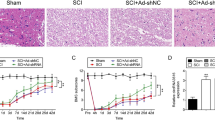Abstract
Background
Spinal cord injury (SCI) can cause destructive neurological dysfunctions.
Objectives
The present study investigates the role and mechanism of methyltransferase like 3 (METTL3) in neural functional recovery post-SCI.
Results
SCI mice showed neurological function impairment, with significantly elevated METTL3 expression and m6A content. METTL3 inhibition improved motor and sensory injury in SCI mice, alleviated tissue injury, up-regulated BDNF, GDNF, and IL-10 levels, and down-regulated IL-1β and TNF-α levels. Mechanistically, METTL3 mediated m6A modification of USP4 mRNA and enhanced YTHDF2 enrichment on USP4 mRNA, thus reducing USP4 mRNA stability and expression. Combined experiments confirmed that METTL3 exacerbated neurological impairment in SCI mice by reducing USP4 expression.
Conclusion
METTL3-dominated m6A modification enhances YTHDF2 enrichment on USP4 mRNA and thereby reduces USP4 mRNA stability, eventually aggravating neurological impairment in SCI mice.





Similar content being viewed by others
Data availability
The data used to support the findings of this study are available from the corresponding authors upon request.
References
Anckar J, Bonni A (2015) Regulation of neuronal morphogenesis and positioning by ubiquitin-specific proteases in the cerebellum. PLoS ONE 10:e0117076
Anjum A et al (2020) Spinal Cord Injury: Pathophysiology, Multimolecular Interactions, and Underlying Recovery Mechanisms. Int J Mol Sci 21:7533
Basso DM, Beattie MS, Bresnahan JC (1995) A sensitive and reliable locomotor rating scale for open field testing in rats. J Neurotrauma 12:1–21
Chen Y et al (2021) Silencing of METTL3 effectively hinders invasion and metastasis of prostate cancer cells. Theranostics 11:7640–7657
Chien CS et al (2021) METTL3-dependent N(6)-methyladenosine RNA modification mediates the atherogenic inflammatory cascades in vascular endothelium. Proc Natl Acad Sci USA 118:e2025070118
Fan B et al (2018) Microenvironment Imbalance of Spinal Cord Injury. Cell Transplant 27:853–866
Gao G et al (2022) METTL14 promotes apoptosis of spinal cord neurons by inducing EEF1A2 m6A methylation in spinal cord injury. Cell Death Discov 8:15
Ge X et al (2023) USP1/UAF1-Stabilized METTL3 Promotes Reactive Astrogliosis and Improves Functional Recovery after Spinal Cord Injury through m(6)A Modification of YAP1 mRNA. J Neurosci 43:1456–1474
Guo S et al (2023) METTL3 Affects Spinal Cord Neuronal Apoptosis by Regulating Bcl-2 m6A Modifications After Spinal Cord Injury. Neurospine 20:623–636
He X et al (2023) METTL3-Mediated N6-Methyladenosine Modification of lncRNA D26496 Suppresses the Proliferation and Migration of Schwann Cells after Sciatic Nerve Injury. Mol Neurobiol 60:2413–2425
Hu B et al (2021) Spotlight on USP4: Structure, Function, and Regulation. Front Cell Dev Biol 9:595159
Jiang X et al (2017) Downregulation of USP4 Promotes Activation of Microglia and Subsequent Neuronal Inflammation in Rat Spinal Cord After Injury. Neurochem Res 42:3245–3253
Jiang X et al (2021) The role of m6A modification in the biological functions and diseases. Signal Transduct Target Ther 6:74
Karsy M, Hawryluk G (2019) Modern Medical Management of Spinal Cord Injury. Curr Neurol Neurosci Rep 19:65
Li C et al (2022) Comprehensive analysis of m6A methylation modification in chronic spinal cord injury in mice. J Orthop Res. https://doi.org/10.1002/jor.25457. (PMID: 36205185)
Liu C et al (2017) Increased Expression of Ubiquitin-Specific Protease 4 Participates in Neuronal Apoptosis After Intracerebral Hemorrhage in Adult Rats. Cell Mol Neurobiol 37:427–435
Liu D et al (2022) N6-methyladenosine modification: A potential regulatory mechanism in spinal cord injury. Front Cell Neurosci 16:989637
Livak KJ, Schmittgen TD (2001) Analysis of relative gene expression data using real-time quantitative PCR and the 2(-Delta Delta C(T)) Method. Methods 25:402–408
National Research Council (US) (2011) Guide for the Care and Use of Laboratory Animals, 8th edn. National Academies Press (US), Washington (DC). https://doi.org/10.17226/12910 (PMID: 21595115)
Ni S et al (2022) Alteration of m(6)A epitranscriptomic tagging of ribonucleic acids after spinal cord injury in mice. Front Neurosci 16:904573
Pourkhodadad S, Oryan S, Hadipour MM, Kaka G, Sadraie SH (2021) Minocycline Enhance the Restorative Ability of Olfactory Ensheathing Cells by the Upregulation of BDNF and GDNF Expression After Spinal Cord Injury. Basic Clin Neurosci 12:777–788
Venkatesh K, Ghosh SK, Mullick M, Manivasagam G, Sen D (2019) Spinal cord injury: pathophysiology, treatment strategies, associated challenges, and future implications. Cell Tissue Res 377:125–151
Wang X et al (2020) miR-30b Promotes spinal cord sensory function recovery via the Sema3A/NRP-1/PlexinA1/RhoA/ROCK Pathway. J Cell Mol Med 24:12285–12297
Xing L et al (2021) Epitranscriptomic m6A regulation following spinal cord injury. J Neurosci Res 99:843–857
Xu S et al (2020) Oxygen glucose deprivation/re-oxygenation-induced neuronal cell death is associated with Lnc-D63785 m6A methylation and miR-422a accumulation. Cell Death Dis 11:816
Yoon KJ et al (2017) Temporal Control of Mammalian Cortical Neurogenesis by m(6)A Methylation. Cell 171(877–889):e817
Zhu H et al (2017) MicroRNA-494 improves functional recovery and inhibits apoptosis by modulating PTEN/AKT/mTOR pathway in rats after spinal cord injury. Biomed Pharmacother 92:879–887
Acknowledgments
Not applicable.
Funding
There was no funding for the study.
Author information
Authors and Affiliations
Contributions
YY conducted the experiment and wrote the manuscript. YY and ZW designed the structure of the article. ZY and DZ were responsible for the literature searches and analyses. All authors contributed to and have approved the final article.
Corresponding author
Ethics declarations
Conflict of interest
Yanbo Yu, Zhisheng Wu, Ziqiang Yu and Daying Zhang declare no conflicts of interest.
Ethical approval
All animal experiment schemes were approved by the Animal Ethics Committee of The First Affiliated Hospital of Nanchang University. Animal experiments were implemented based on the Guide for the Care and Use of Laboratory Animals (National Research Council (US) 2011).
Additional information
Publisher's Note
Springer Nature remains neutral with regard to jurisdictional claims in published maps and institutional affiliations.
Rights and permissions
Springer Nature or its licensor (e.g. a society or other partner) holds exclusive rights to this article under a publishing agreement with the author(s) or other rightsholder(s); author self-archiving of the accepted manuscript version of this article is solely governed by the terms of such publishing agreement and applicable law.
About this article
Cite this article
Yu, Y., Wu, Z., Yu, Z. et al. Knockout of METTL3 promotes neural functional recovery after spinal cord injury in mice via the USP4/YTHDF2 axis. Mol. Cell. Toxicol. (2023). https://doi.org/10.1007/s13273-023-00393-8
Accepted:
Published:
DOI: https://doi.org/10.1007/s13273-023-00393-8




